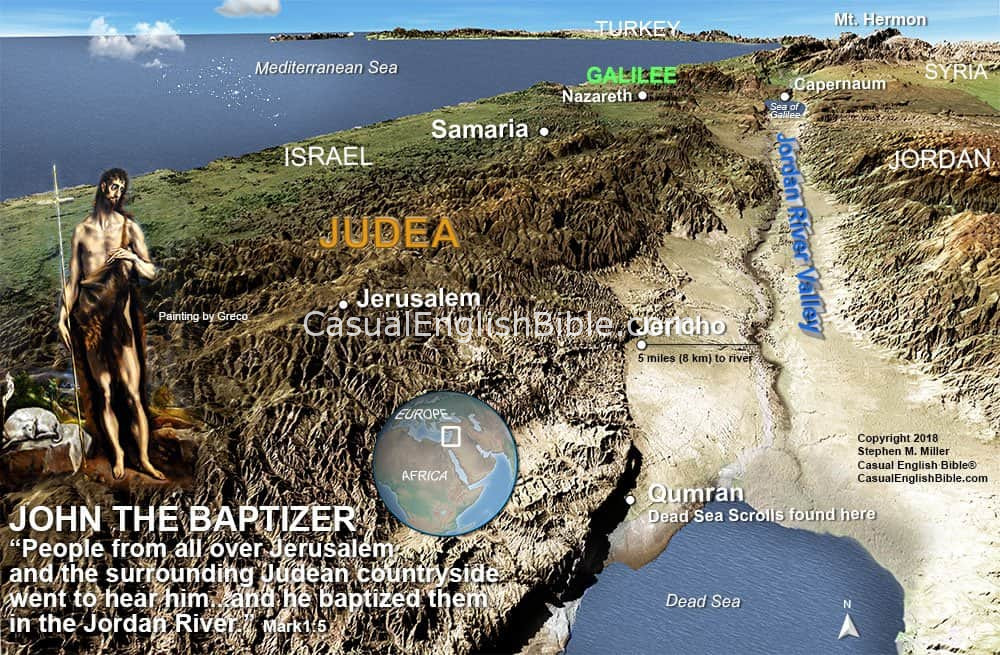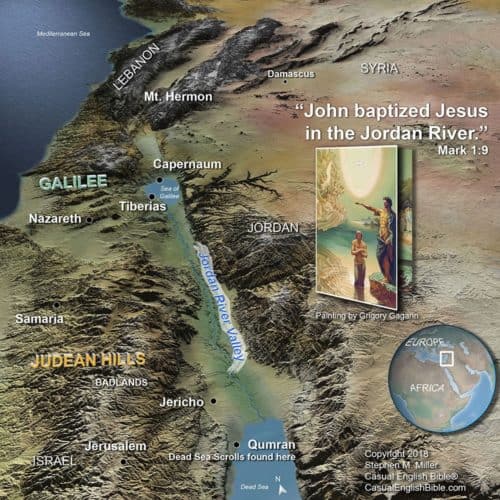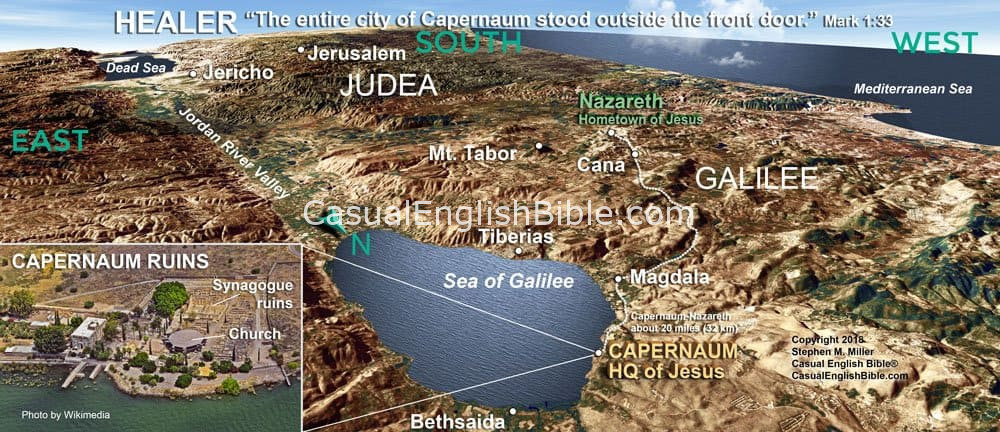Mark 1
Jesus launches his ministry
John the Baptizer: Advance Man for Jesus
1This is the beginning of the story of Jesus the Messiah, the Son of God. It’s good news. [1] 2The prophet Isaiah wrote about what was going to happen.“Look, I’m sending my messenger ahead of you
to get everything ready for you.
‘Get ready, the Lord is coming.
Clear the road and make it straight.’” [2] 4John the Baptizer [3] launched his ministry in the badlands. He preached that people should get baptized. He said it would show that: they regretted [4] their sins, they were going to start saying no to sin, and their sins were forgiven. [5]
5People from all over Jerusalem and the surrounding Judean countryside went to hear him. They confessed their sins, and he baptized them in the Jordan River. 6John wore clothes woven from camel hair, [6] which he tied around his waist with a leather belt. He ate locusts [7] and wild honey. 7When John preached, he told the people, “Listen, someone is coming who’s more important than me. I’m not worthy to untie the straps on his sandals. 8I baptize you with water. But he’ll baptize you with the Holy Spirit.”
John Baptizes Jesus
9While all this was going on, Jesus came down from the city of Nazareth. That’s in the region of Galilee. John baptized Jesus in the Jordan River. 10As Jesus came up from the water, he saw [8] the heavens open and the Spirit come down to him like a dove. 11A voice from somewhere in the sky said, “You are my Son. [9] I dearly love you. And I want you to know how pleased I am with you.” 12Right away, the Spirit compelled Jesus to leave the river valley and go into the badlands. 13He stayed in the badlands for 40 days. [10] He wasn’t alone. There were wild animals. Satan came and tempted him. Angels came to help him.Rabbi Jesus Starts His Ministry
14After John was arrested, [11] Jesus went back to Galilee and started telling people the good news from God. 15Jesus told everyone, “God’s kingdom has come. [12] People have expected it for a long time. Well, it’s here. So now is the time to stop sinning and to start believing the good news.”16One day when Jesus was walking alongside the Sea of Galilee, he saw two fishermen throwing a net into the lake. They were brothers, Simon and Andrew. 17Jesus told the men, “Come and follow me. When I’m done with you, you’ll be fishing for people.” 18They didn’t hesitate. They left their nets and off they went, following him.
19A little later, he saw the brothers James and John, sons of Zebedee. They were in their fishing boat, repairing their nets. 20Right away, he invited them to follow him. They did. They left their father Zebedee in the boat with his hired men. They followed Jesus.
Jesus Exorcises a Demon in a Synagogue
21They went over to Capernaum. On the very next Sabbath, Jesus went into Capernaum’s synagogue and started to teach. 22People were astonished at what he said and how he said it. He didn’t teach like others. [13] Jesus spoke with authority, as though other folks should be quoting him.23Suddenly a man possessed by a demonic spirit interrupted the synagogue service by speaking out. 24He said, “Jesus of Nazareth, what do you want with us? Are you here to kill us? I know who you are. You’re God’s Holy One.”
25Jesus put a quick end to that conversation. He said, “Stop talking and come out of that man.” 26The demon spirit twisted the man’s body into convulsions. Then the demon screamed and came out.
27Everyone was astonished. They started asking each other, “What’s going on here? Is this some kind of a new teaching with some special authority? Not only does this man give orders to demonic spirits, but the demons obey him.” 28That’s all it took. The fame of Jesus quickly spread throughout all of Galilee and the neighboring villages.
Jesus, the Healer
29Jesus left the synagogue and went to the house of Simon and Andrew. James and John went with them. 30Simon’s mother-in-law was lying down, sick with a fever. People in the house told Jesus about that as soon as he got there. 31Jesus took her by the hand and helped her up. Suddenly, the fever left her. She started waiting on them and serving them food.32As soon as the Saturday Sabbath ended at sundown, people started bringing the sick and demon-possessed to Jesus. 33The entire city of Capernaum stood outside the front door of the house. 34Jesus healed a lot of people who were sick with different diseases. He exorcised many demons as well. He wouldn’t let them speak because they knew who he was.
35Early the next morning, before sunrise, Jesus left the house. He took a walk to a place where he could be alone and spend some time in prayer. 36Simon and the others who had been following Jesus started to look for him. 37When they found Jesus they said, “Everyone is out looking for you.”
38Jesus simply said, “Let’s go to one of the neighboring towns so I can preach there as well. That’s what I came here to do.” 39Jesus traveled to towns all over Galilee. He preached in their synagogues and exorcised demons wherever he went.
Jesus to Healed Leper: “Don’t Say a Word to Anyone”
40A man with leprosy [14] came to Jesus, dropped to his knees, and pleaded for help. The man said, “If you want to, I know you can cleanse me of this disease.”41“I want to,” Jesus said. What Jesus saw made him sick to his stomach. Moved with compassion, [15] he reached out his hand and touched the man. [16] As he did, he said, “Clean.” 42In that moment, the man’s leprosy vanished. He was clean again.
43Jesus sent him away with a critically important warning. 44Jesus told the man, “Listen to me, I’m deadly serious. Don’t say a word to anyone about this. Instead, I want you to go straight to the priest, as the law of Moses says you’re supposed to do. Take the required sacrificial offering. [17] That way the priest can let everyone know that you’re clean.” 45Instead, the man told everyone wherever he went. Jesus suddenly became so popular that he couldn’t go into a town, unless he went secretly. So he stayed outside of towns and villages. That didn’t stop the crowds at all. People came to him from all over.
Footnotes
The Greek word for “good news” is euangelion, from which we get words such as evangelize and evangelical. It’s a way of referring to the story and teachings of Jesus, and the great news about everlasting life.
Isaiah 40:3
Mark doesn’t call him John the Baptist. Mark is the most action-packed story about Jesus in the Bible. This is one of the ways Mark puts a little extra action into the story. Instead of giving John a passive title, Mark adds action to the title. John isn’t someone who simply talks about baptism. John is someone who goes around baptizing people so much that people call him the Baptizer.
Often translated as “repented.” It’s from a Greek word that conveys the idea of someone making a U-turn in their life. In this context, it’s as though they see God in the rearview mirror and abruptly make a course correction. Suddenly, everything changes: the direction in life, the scenery, and the destination.
A more literal translation says that John preached “a baptism of repentance for the forgiveness of sins.” Bible scholars have different ways of explaining what this means.
Hair on the outside of a camel is coarse and stiff, but it can be woven into threads. Hair underneath this “guard hair” is shorter, softer, and more insulating. People can also weave this “undercoat” into thread, often blending it with other fabrics such as wool, though Jews weren’t supposed to mix fabrics, according to the law of Moses (Leviticus 19:19). Fashion designers sometimes use camel hair in their clothing.
Locusts John ate were probably migratory grasshoppers with wings. They hatch in the Arabian deserts, where there were few predators to eat them. Desert windstorms blow them west into what is now Israel, Egypt, and beyond. Locusts remain a problem even in modern times, in spite of insecticides and strategies for killing them.
Jesus may have seen a vision. The combination of “he saw” and “the heavens open” follows a technique that other Bible writers used to describe a vision (Revelation 19:11; Acts 7:56).
See the footnote for Luke’s version of the quote, reported in Luke 3:22.
“Forty days” was a way of saying several weeks, or a stretch of time much longer than most folks would want relatives to visit.
See the story of John’s arrest and execution, reported in Matthew 14:1-12.
Or “is almost here.”
It was popular to teach the Jewish faith by reminding the people what rabbis and other revered Jewish scholars from previous generations had to say on a topic. Preachers today do the same thing when they quote theologians and other scholars, past and present.
Writers in Bible times use the word “leprosy” to describe many different kinds of skin diseases. Today, leprosy has a much narrower definition and is called Hansen’s disease.
The Greek word often translated as “compassion” literally means something that can be translated today as “guts” or “intestines.” Scholars say that English translations don’t really do justice to the term. Compassion, empathy, pity, and anger convey just part of what was going on inside Jesus. When Jesus saw this man’s suffering, it made him sick to his stomach.
People with serious skin diseases were considered ritually unclean. They were not allowed to worship in the Temple. Anyone who touched them was considered ritually unclean as well and had to go through cleansing rituals. See Leviticus 5:3. For cleansing rituals for people with leprosy, see Leviticus 14.
Two live birds, according to Leviticus 14:4.
Discussion Questions
- 1
It’s rare that Bible writers describe a person’s fashion sense and eating habits. Mark reports this about John the Baptizer, “John wore clothes woven from camel hair, which he tied around his waist with a leather belt. He ate locusts and wild honey” (Mark 1:6). Why do you think Mark reported this?
- 2
John told the people, “I baptize you with water. But he’ll baptize you with the Holy Spirit” (Mark 1:8). Some Bible experts say this suggests that once the Holy Spirit comes, you won’t need to get baptized with water anymore. How do you react to that?
- 3
Mark says that when Jesus was baptized, “he saw the heavens open and the Spirit come down to him like a dove” (Mark 1:10). The footnote to that verse suggests that Jesus saw a vision of the Holy Spirit coming down to him like a dove. But the Gospel of Luke says, “The Holy Spirit came down in physical form, like a dove” (Luke 3:22). There’s no indication that either writer had ever met Jesus. Both seem to have collected their information about Jesus from various sources. How you react to the apparent inconsistency in these two reports?
- 4
After Jesus was baptized, Mark says a voice from the sky said, “You are my Son. I dearly love you. And I want you to know how pleased I am with you” (Mark 1:11). Luke 3:22 reports the same quote. But one ancient manuscript adds to Luke’s quote, “Today I have begotten you.” Some Bible experts say that this addition suggests that on the day Jesus was baptized, God adopted Jesus as his. A Christian group known as Ebionites taught this idea early in the Christian movement. How do you react to the fact that this phrase shows up in an ancient copy of the Gospel of Luke?
- 5
Mark has one sentence about Satan tempting Jesus: “Satan came and tempted him” (Mark 1:13). The Gospels of Matthew and Luke each use about a dozen verses to tell the story. Why do you think Mark gave it just a hurried mention?
- 6
“Jesus told everyone, ‘God’s kingdom has come’” (Mark 1:15). Bible experts don’t agree that this quote of Jesus is correctly translated. Some say Jesus was saying God’s kingdom is near. What kingdom do you think he was talking about, and how was it near?
- 7
As Mark reports it, Andrew and his brother Simon, better known as Peter, instantly accepted the invitation of Jesus to become one of his disciples. “They left their nets and off they went” (Mark 1:18). Ditto for the brothers James and John (Mark 1:19). Really? What would you guess is the backstory here? Why did these disciples drop everything and follow Jesus like it was some kind of emergency?
- 8
Some Christians don’t buy into the idea that Satan is a sentient spirit being at work in the world. They prefer to think of satanic evil as a pervasive and perverted behavior that manifests itself in a lot of different ways, including some that could be confused with demon possession. But in the stories of Jesus exorcising demons, he’s talking out loud with them. How do you think Christians who would reject the idea of Satan as an entity would explain what’s going on with these exorcisms?
- 9
One of the big “why” questions in this chapter is why Jesus would heal a man of leprosy or whatever the skin disease was, and then tell the man, “Don’t say a word to anyone about this” (Mark 1:44). I mean, come on, we have leprosy one morning, we get healed in the afternoon, someone asks us what happened, and we say, “Can’t say.” Not going to happen. Why would Jesus tell him to keep it quiet?
- 10
LIFE APPLICATION. The Casual English Bible says John the Baptizer taught that baptism “would show that: they regretted their sins, they were going to start saying no to sin, and their sins were forgiven” (Mark 1:4). The footnote to the verse adds this: “A more literal translation says that John preached ‘a baptism of repentance for the forgiveness of sins.’ Bible scholars have different ways of explaining what this means.” What do you think baptism means to most Christians today?
- 11
LIFE APPLICATION. The Greek word that describes the compassion Jesus felt when he saw the leper is splanchnizomai (splonk-NEES-oh-my). It means “guts” or “intestines.” The Casual English Bible explains it this way: “What Jesus saw made him sick to his stomach. Moved with compassion” Jesus healed the man (Mark 1:41). There are plenty of wrenching illnesses and diseases that sicken us when we see them tearing people up. What are some you have seen that bothered you most?









